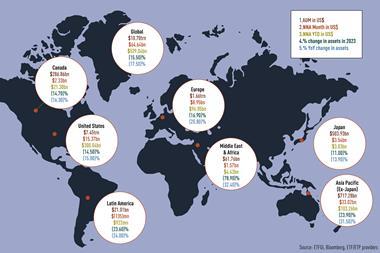The number of ETFs listed on Europe’s exchanges is not far behind the amount in the US, but in terms of assets under management, Europe still has a long way to go.
At the end of October, there were 111 ETFs listed in Europe compared with 149 in the US, according to data from Morgan Stanley. Hwever, ssets under management stood at $30.60bn (e23.4m) in Europe against $188.67bn in the US.
But in percentage terms, the growth in ETF assets far outpaces the growth in the US. In Europe, assets under management were up by around 50% from $20.44bn in 2003, while in the US, the climb was around 25%.
Lars Hamich, managing director of Stoxx, notes that the range of ETF products available in Europe is still broadening. Even though the ETF market is dominated by blue chips, there is an increasing number of non-blue chip products now listed.
“This is good,” he says. “It tells us it is no longer a one-dimensional play.” Investors now have the opportunity to place some size bets , with small cap ETFs, for example, now offered. In the second half of 2003 and the first half of 2004, interest in ETFs was very quiet, says Hamich, but in the third quarter of 2004, demand made a noticeable recovery, he says.
Stoxx licensed its six Dow Jones EURO STOXX Style indices as well as the Dow Jones EURO STOXX Small, Mid and Large Cap indices to Barclays Global Investors as the underlying for new iShares ETFs. These are the first value, growth and size indices in Europe which have been licensed for use as ETFs, although investors in the US have been able to use such products for two years now.
“It’s a good sign that European offerings are following the US,” says Hamich. He predicts that there will be many new ETFs launched in February 2005.
Deborah Fuhr, executive director at Morgan Stanley in London, says the use of ETFs will grow as UCITS 3 is implemented. Under current regulations, funds can technically only invest up to 5% of their fund in other funds.
But under UCITS 3, this ceiling will be raised to 20% and allow up to five funds and ETFs which are deemed to be UCITS-compliant. “This opens up the scope,” Fuhr says.
Industry participants predict more commodity-based ETFs. So far, two ETFs based on gold have been created – streetTRACKS Gold Trust and iShares Gold Trust – both US-listed. The streetTRACKS product began trading in November, while the iShares ETF is expected to go live in January.
Chris O’Brien, vice-president marketing and sales, S&P Europe and Asia, believes the market will witness the introduction of more ETFs in real estate. “I think we’ll continue to see new products in terms of style and size slices,” he says.
ETFs have become more accepted by investors in the last year or so, but providers say they still have a job to do in showing how useful they can be.
“We still see knowledge about these instruments being lower in Europe than in the US,” says Chris Sutton, chief executive of iShares Europe and Asia (ex Japan).
Within Europe, awareness of ETFs varies. It is strong in Germany and the Netherlands, says Sutton, and in France, too, a survey has shown. Their profile is lower in the UK, though, he says.












No comments yet